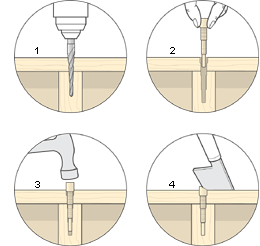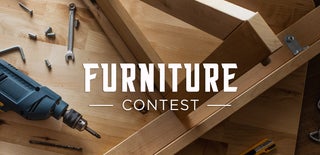Introduction: Storage Bed
Beds take up a lot of space and even if they have drawers in them, they're often flimsy and not especially capacious. This storage bed is easy and inexpensive to make and features three storage boxes designed to house infrequently accessed stuff like out-of-season clothing, sports equipment, or anything else that you don't use often but don't want to get rid of. Their capacity is maximized by foregoing drawer slides or wheels, and just resting the boxes on the carpet. They have a total volume of ~100 gallons (400 litres) - about the same as 3 extra-large suitcases.

Step 1: Materials and Tools
You will need the following materials:
- Three sheets of 5/8" (15 mm) plywood
- Two 8' lengths of 12" (285 mm) 3/4" thick "project board"
- Two 8' lengths of 2 x 4 construction lumber
- wood glue
- 3" deck screws
- Miller dowels
...and the following tools:
- table saw (or circular saw with guide)
- cordless drill/driver
- nailgun
- hammer
- orbital sander
- router with roundover and square bits
- clamps
Step 2: Design
This changed a lot over the course of the build and indeed could be streamlined further. I made the bed out of leftover plywood and lumber from the dismantling of a bunk bed and what was in my shop. Here's an explosion of the bedframe (thanks to jonatron for the instructions):

The design pictures were created in Fusion360 (free to students and hobbyists) and the plans are available online at https://a360.co/2N1LOGS.
Step 3: Cut
I did this with a mix of table saw, miter saw and circular saw, but all of it can be done with a circular saw and guide. For those of you who prefer feet and inches, conversion is 1 inch = 25.4 mm.
Construction lumber (three 8' lengths of 2 × 4)
- Cut one piece 1922 mm in length. Rip in half, so you have two pieces 1922 × 38 × 42 mm.
- Cut another piece into one length of 845 mm. Rip in half.
- Cut one piece into two lengths of 922 mm. Rip both in half, then trim one to 845 mm. You should have three lengths of 922 × 38 × 42 mm and three of 845 × 38 × 42 mm.
- Cut the offcuts into 6 pieces 258 × 88 × 38 mm.
- Rip one 922 × 38 × 42 mm piece into two 922 × 17 × 42 mm pieces, one 845 × 38 × 42 mm piece into two 845 x 17 × 42 mm pieces, and two 258 × 88 × 38 mm pieces into four 258 × 88 × 17 mm pieces.
2 project boards (8' long, 12" wide, 3/4" thick = 2440 × 285 x 18 mm)
- Rip one board into three pieces 75 mm wide, leaving one piece 55 mm wide.
- Cut the 75 mm wide boards into two 1988 mm lengths and two 937 mm lengths.
- Cut the 55 mm wide board into eight 300 mm lengths.
- Cut offcuts into four pieces 300 × 37 mm.
- Cut the other project board into three pieces 580 × 285 mm (285 mm = project board width).
3 sheets of 5/8" (15 mm) Plywood
- 1945 × 930 mm (bed top)
- 1952 × 342 mm (bed side)
- Two 922 × 342 mm (bed ends)
- Six 905 × 250 mm (box sides)
- Three 570 × 250 mm (box backs)
- Three 920 × 570 mm (box bases)
Step 4: Make Frame
Screw the pieces together as shown for the two central frame pieces using deck screws. Clamp before screwing for maximum precision.
Glue and nailgun the half-thickness pieces in the same configuration to the two pieces of 922 × 345 mm plywood (if you look closely, you'll see I used 1" drywall screws, but only because I'd forgotten about my nailgun!).
Stand the frame pieces up and screw them to the 1922 × 38 × 42 mm pieces as shown. The spaces between frames should all be the same size.
Step 5: Finish Bed Frame
Screw the 1952 × 345 mm piece of plywood to the back, then glue and Miller dowel the project board trim to the frame. I really like Miller dowels - they look good, they're easy to use, they're very precise, and they enable you to make large furniture with a minimum of fussing about. Basically, you clamp the pieces together exactly where you want them and drill holes with a special stepped bit. Remove the clamps, glue, then hammer the glued Miller dowels in.

The beauty of the method is that the hammering forces the pieces very firmly together and you can immediately move on to the next step, so you need an absolute minimum of clamps. Because the glue is doing most of the work, I don't use many - maybe a dowel every 8" (200 mm) or so, with a minimum of 2 dowels per piece.
If you prefer other forms of construction, by all means use them. Biscuits, normal dowels, or just nailgun if you can bear the holes (or are prepared to fill them afterwards).
Sand the finished frame, paying close attention to the flush-cut Miller dowel heads, ensuring they are sanded down completely level with the surface.
Step 6: Storage Boxes
The boxes are simply constructed from plywood, using glue and a nailgun for the four plywood sides, and Miller dowels for the front. I reinforced the inside corners with strips of 12 × 12 mm (1/2 × 1/2") wood to make the assembly easier as much as to make the box stronger. Order of construction: I attached the sides to the base first, then added the back, and finally the front. The front should overlap the sides by a mm or two on each side, and then trimmed exactly using a router with a flush cutting bit.
The bottom edges of the boxes were all given a rounded edge using a router with a roundover bit.
Step 7: Handle
I routed these into the box fronts using a square router bit and a template and then a roundover bit. They're 25 mm high and 85 mm wide. The template should be [2×(distance from the bit to the edge of the router) + 25] by [2×(distance from the bit to the edge of the router) + 85] in internal dimension. Your router base should be circular; I used a little hand router which was perfect for this task (if somewhat slow - probably the most tedious part of this build, so by all means use some sturdy drawer pulls if you'd rather!).
Step 8: Finish
We put 3 coats of clear finish on, sanding before the last coat.
The photo gives you a sense of the size of the boxes. Total capacity of all three is about 400 liters (100 gallons, 14 cubic feet)! Or to put it another way: each box is bigger than the biggest suitcase that can be checked on an international flight (limit 62 linear inches). That's some serious storage capacity. They slide in and out easily on the carpet, even when full.
Step 9: Install
Put the bed into position, drop the plywood top on, add a mattress & bedding, and load up the boxes with all those out-of-season clothes and sports equipment and anything else rarely accessed. Slide the boxes under the bed and forget about them until next season.
Note that if you want to store anything dense (like books) the boxes are going to be harder to move because of their size. They're really meant for lighter, bulkier items. If you want to store books, consider building a secret door bookcase instead.
Step 10: Other Sizes: Queen & King
This general plan works well for other sizes of bed, too. I also made a queen size one (custom size to fit over a hearth, in a den-converted-into-a-bedroom) and a king size one as well. The queen has 6 drawers, three of which can be accessed from each side. The king I made in two halves which got joined together once in the room (king size bed bases come like this because they're bulky and impossible to get into rooms otherwise). It also made it easier to build. The king has three storage boxes each side, but they use only 3/4 of the available space. This decision was made because the storage boxes closest to the wall would be inaccessible anyway. I didn't document these builds in detail, but the pictures will show the similarity in concept. We've added a massive amount of storage with these 3 beds (& 15 large drawers), handy in a house that has no attic or crawl space.

Runner Up in the
Furniture Contest













